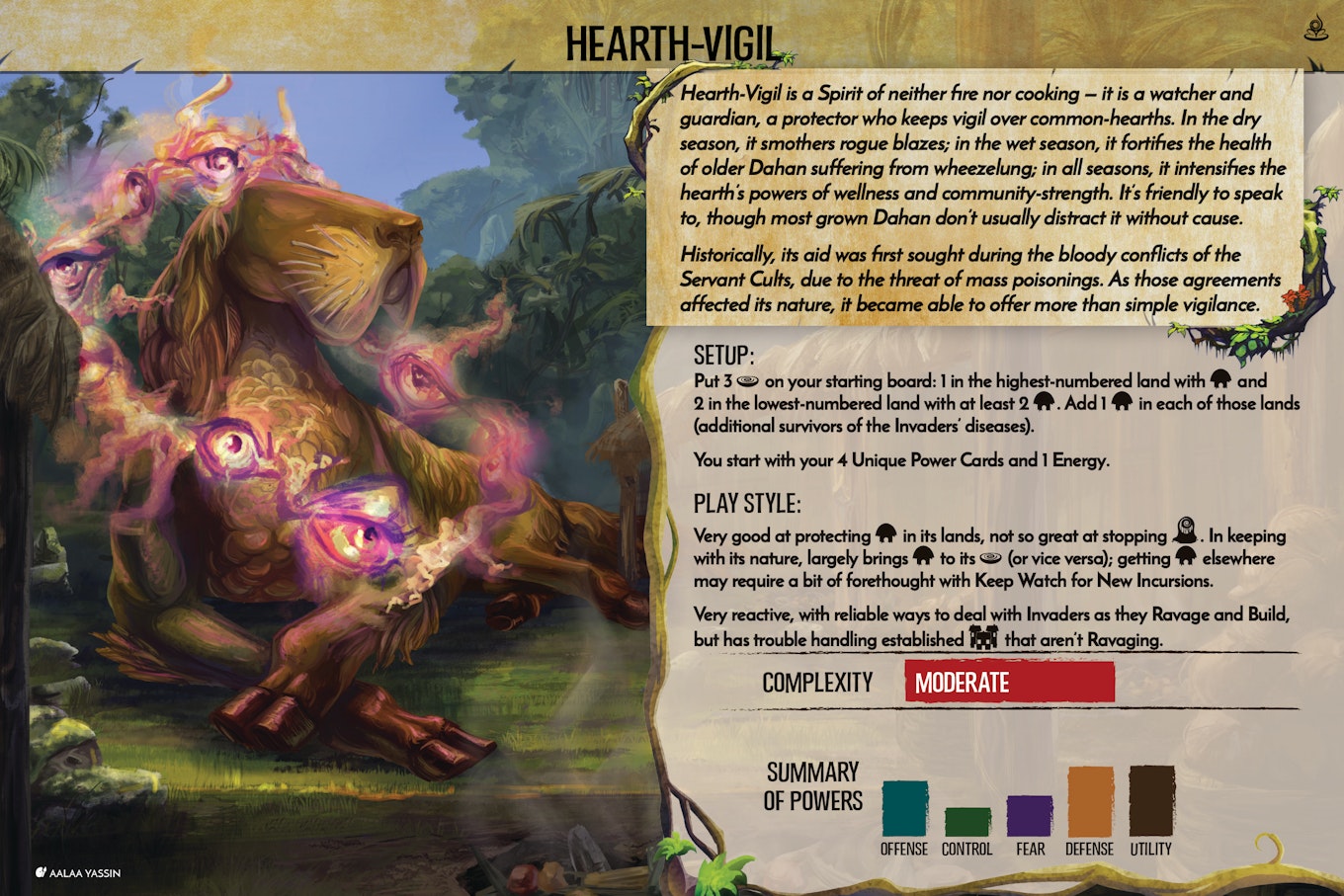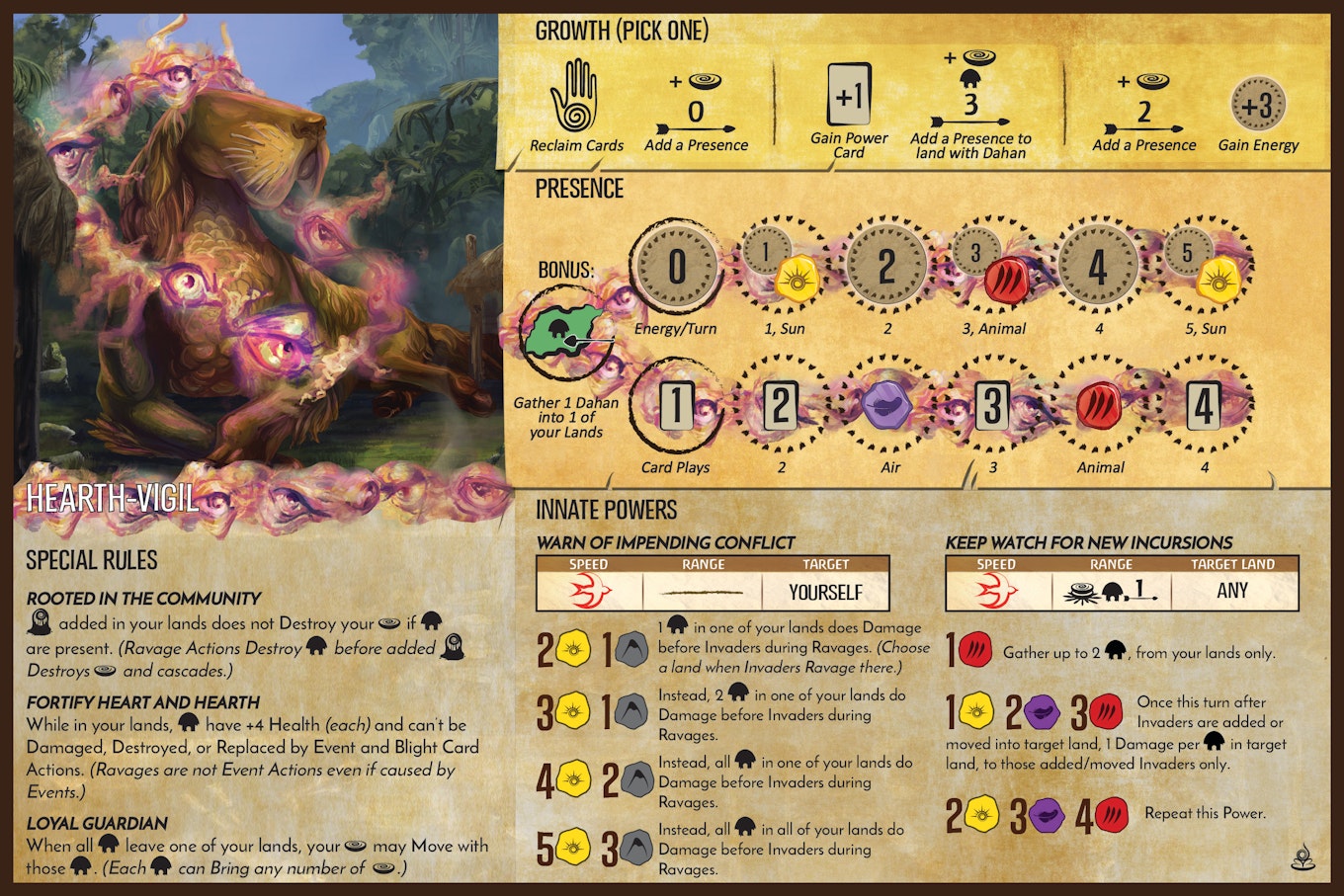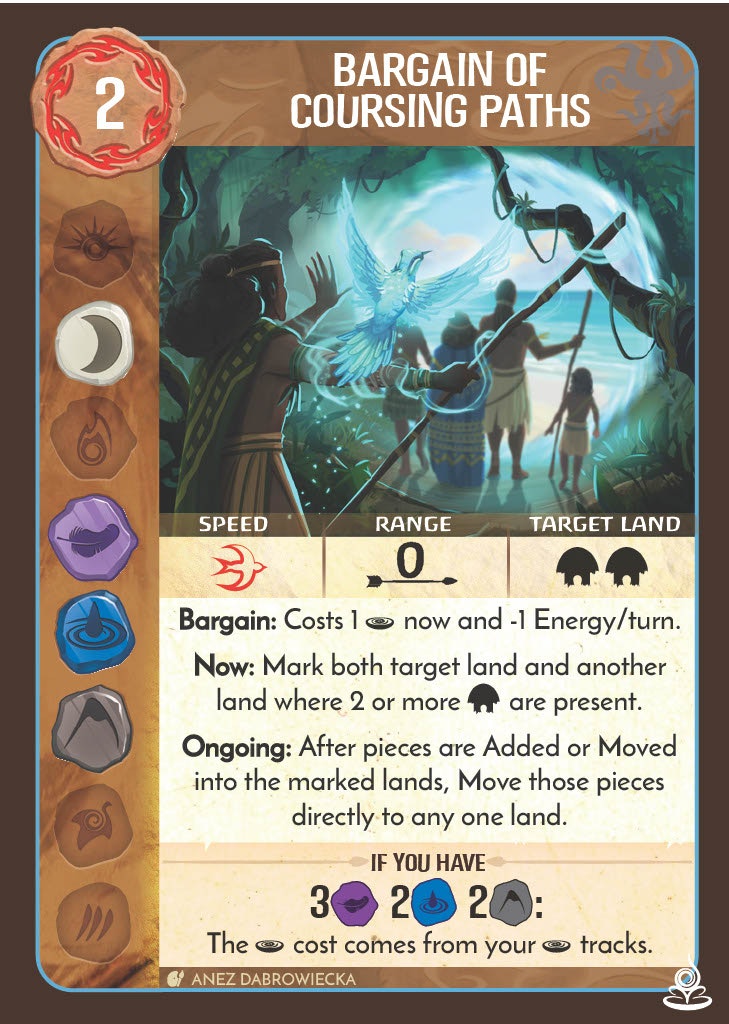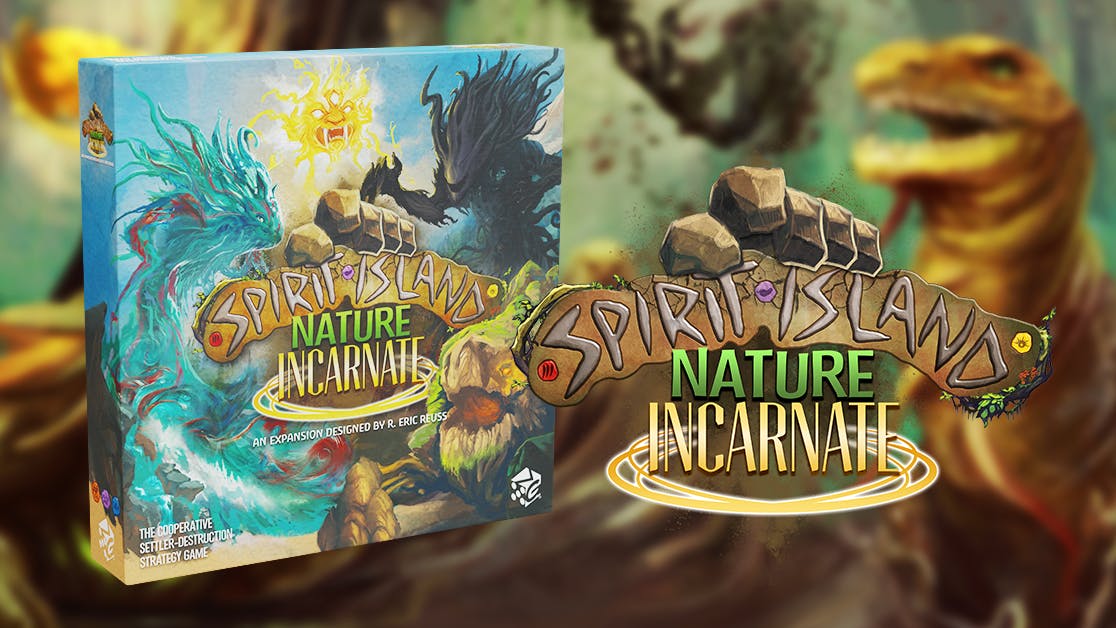Project Update: Spirit Reveal: Hearth-Vigil
Update number two for today! As promised, we’re continuing with a Spirit reveal for Hearth-Vigil with writing by R. Eric Reuss and member of the development team Nick Raele. They’ve got a lot to tell you about Hearth-Vigil, plus our bonus card at the end of the post! Here is R. Eric Ruess on the story and design of our first non-Incarna spirit feature: Hearth-Vigil.
Story
Long long ago, before Hearth-Vigil associated with humans, it was a watching-Spirit, small but not tiny, somewhat territorial. Nearby Dahan knew of its existence, and generally steered clear of it - why take the chance? That changed some time after the Second Reckoning: the institution of spirit-speakers had resulted in an expanding body of understanding and lore about Spirits, the changed relationship between Dahan and Spirits had led to higher confidence among the Dahan, and that confidence plus increasing Dahan population led to a higher absolute number of people willing to take possibly-stupid chances on contacting possibly-hostile Spirits.
In this case, the chance paid off: some brave and observant Dahan who lived nearby figured out what patterns, stories, actions, and offerings this watching-Spirit found pleasing, and over time gained its trust. It allowed them to pass rather than chasing them off. Over time, it grew a bit in complexity and strength trying to better understand these likable beings; eventually it became able to communicate with them tolerably well.
This pattern of arriving at mutual understanding (and perhaps a bit of Spirit growth) isn’t remotely unique to Hearth-Vigil, but when it happens, it usually ends there: a lesser Spirit and the Dahan in the area come to be on decent terms, can communicate tolerably well, and keep a bit of a neighborly eye on what’s going on with each other.
Hearth-Vigil veered off of this path when the conflicts of the Servant Cults erupted, sending the Dahan into a period of bloodshed unprecedented on the island. Raiding (unannounced strikes, purposeful slaughter/destruction, treating targets as not worthy of the consideration extended to people) became more and more common, supplanting the usual systems of warfare (ritualized, low-casualty, embedded in structures of diplomacy and negotiation).
As word spread of communities devastated by ambush-raids or poison snuck into communal food, those who knew Hearth-Vigil approached it, asking, “Would you come to our common-hearths and help protect us? Your senses are keen in ways that ours are not; would you come and make a home among us, so your watchfulness might benefit us as well as you?”
This was not mere supplication, of course: these Dahan made a carefully thought out and balanced bargain with pleasing offerings, judicious agreements for the future, and - as is the Dahan custom - a finite duration. This was partly to better appeal to Hearth-Vigil (though the spirit-speakers among them thought its nature would incline it to the agreement), but just as much to pin down that they did not owe it any form of obedience or worship - while most of the families involved had not yet joined in the conflict, they already had a strong distrust of the Servants, tempered only by fear of how much unseen power the Servants might have.
Hearth-Vigil is not sworn to the Dahan in quite the same way that Thunderspeaker is - its initial agreements have long since expired, but after generations of living among the Dahan, it finds it comfortable to continue doing so… which has proved fortunate since first contact with the Invaders.

A game of Spirit Island does not open at the very instant the Invaders show up: the first tall ship landed at the island around 8 to 10 years before game start, the first colonists arrived maybe 4 to 6 years back. The opening acts of the eventual conflict are presumed to play out similarly each time, so are left invisible: the initial settlements, the Dahan reaching out to the colonizers, the Invaders failing to heed Dahan warnings about proper behavior, the first Blight, larger Spirits being caught by surprise at the speed of the Invaders… and Invader-borne diseases ripping through the interconnected Dahan population.
It is horrifying that the mortality rate among the Dahan - around 20 to 30 percent - is substantially less than what was historically suffered by many Indigenous communities in the face of such pathogenic onslaughts. Most Dahan communities benefited from close relationships with some smaller Spirits able to provide quick palliative assistance, and perhaps blunt the severity of an illness.
However, most Spirits capable of more dramatic aid were unable to react in time or to bring their full power to bear - events unfolded extremely quickly, from their perspective, and these illnesses were novel, unfamiliar.
Hearth-Vigil, however, was able to help a great deal more, being a Spirit both of vigilance and of health, already existing among the Dahan. Communities with a close relationship to Hearth-Vigil are accustomed to bringing their ill or poisoned to it for aid, and this allowed many to survive who otherwise would not have.
(A side note on language: Spirit names attempt to capture feel in addition to literal meaning. “Hearth” is the closest English word in meaning + connotation to the Dahan word for the shared communal space around common pit ovens over which Hearth-Vigil watches - just like Shroud of Silent Mist uses “shroud” due to its connotations in the English language, even though the Dahan don’t generally use burial-shrouds and their name for the Spirit doesn’t reference fabric at all.)
Design
I’ve known for a long time that I wanted more Spirits than just Thunderspeaker whose primary focus was the Dahan, and known for almost as long that I wanted a Spirit whose setup included extra surviving Dahan on the board to call attention to the otherwise-invisible ordeal the Dahan have just survived at the game’s start.
(And while on the surface of things it might make sense to defer Hearth-Vigil to a Dahan-centric expansion, there were a few good reasons not to - the most decisive being that there were no Dahan-centric Spirits in Jagged Earth, and it’d be nice if folks who really like that sort of thing didn’t have to wait.)
Let’s take a look at Hearth-Vigil’s panel:

There are several things here which feed into each other, and some trends that may not be obvious at first glance:
One of Hearth-Vigil’s special rules relies heavily on another: “Dahan have +4 Health in your lands” (Fortify Heart and Hearth) needs “Your Presence isn’t destroyed by Blight if Dahan are present” (Rooted in the Community), because otherwise Ravages can remove the Health buff by destroying your Presence.
That pair of rules means that Hearth-Vigil is really good at enabling Dahan counterattacks - but at the cost of taking Blight. However, its first Innate Power (Warn of Impending Conflict) warns and wards the Dahan, letting them strike first when the Invaders get violent.
Its second Innate Power (Keep Watch For New Incursions) is also reactive, but in a different way. It lets the Dahan react to new Invaders arriving, allowing an attack before they gain a foothold - but doesn’t work against already-entrenched colonists.
Both of these Innate Powers reflect the thematic fact that while Hearth-Vigil is very attentive and alert, that it’s fundamentally a somewhat reactive Spirit. With such reactive Innates, Hearth-Vigil has to rely on Power Cards if it wants to be proactive. A couple of its Unique Powers do give it a bit of damage & Invader control, but it’s likely to be keeping an eye (or several eyes) out for more.
Those Uniques are like its second Innate in that they must target from a land with Dahan. You’d probably already guessed that Hearth-Vigil likes hanging out in lands with Dahan, but it’s worth taking a look at some parts of that dynamic which make it play very differently than a Spirit like Thunderspeaker.
Faced with a situation involving existential threat and lots of new diseases, Dahan would - unsurprisingly - much rather move into Hearth-Vigil’s lands than out of them. It gets a bonus “Gather 1 Dahan into one of your lands” action every Spirit phase, but the only way it has to move Dahan away from its Presence is Keep Watch For New Incursions (its second Innate).
In addition, Hearth-Vigil isn’t as mobile as Thunderspeaker - it can only move its Presence with Dahan when all the Dahan in a land leave; if any stay behind, Hearth-Vigil stays steadfastly with them.
So that first part of Keep Watch For New Incursions is important even when not hitting the later thresholds, because it’s Hearth-Vigil’s only way of moving Dahan to someplace it isn’t.
Dev Notes, by Nick Reale
The initial version of Hearth-Vigil that Eric handed off to us had a fairly simple core strategy: move Dahan into its lands, use its first Innate Power to grant them bonus Health so that they could survive a Ravage and counterattack, and then Push them to the next Ravage. The concept seemed simple and clear enough that it didn’t appear to require much development. Oh were we wrong! Testers found the gameplay to be quite monotonous. Moving Dahan wasn’t even an interesting choice in most board states, since the right place to be was whichever lands were going to Ravage next. We asked Eric to go back to the drawing board and give Hearth-Vigil something more interesting to do.
The result was an Innate Power that targeted from a land with Dahan and did Damage based on the Dahan count there to Invaders added or moved into the target land. Thematically, the Dahan sent out brief raids to handle the new arrivals, but returned to the homes protected by Hearth-Vigil. This solved our problem, since it gave interesting choices without compromising Hearth-Vigil’s inherently reactive nature. However, this led to making giant stacks of Dahan, dubbed “archery towers” or “Dahan artillery” by testers, that would utterly destroy any Invaders that showed up near them. Fixing the theme here clearly involved moving Dahan into target land to represent the raid, but getting the correct variation of that took oh… so… many iterations before we embraced the relative simplicity of the current version. Checking for Dahan in the origin land worked out so well for distinguishing Hearth-Vigil from Thunderspeaker that we expanded that theme into the Unique Powers as well.
While working on that, we also had to fix the first Innate Power. Variable Health bonuses were hard to remember and caused all sorts of Blight on a Spirit that didn’t have a great thematic reason to start the game with a way to clean it up. We tried swapping all sorts of other defensive effects in place of the higher Health bonuses, but the combination made the Power feel a bit unfocused. Ultimately, the simplest version was focusing the Innate Power entirely on Dahan striking first, with the other defensive benefits being Special Rules. The original gameplay of trading Blight for board control remains an option for aggressive players who lean into the Special Rules, while more Blight-averse players can focus on the Innate Powers instead.
Postscript: A Note on ‘More Dahan on the board’
“More Dahan survived the Invaders’ diseases” isn’t the only reason more Dahan could start on an island board.
Spirit Island only uses pieces for things that are relevant to the conflict. E.g., when an Invader piece is Destroyed, there are nearly always survivors - sometimes many! - but since they no longer affect the course of the conflict they aren’t represented. Ditto for Removing Invaders - maybe some remain on the island, but they are few enough in number and/or wary enough in their actions to not affect the large-scale course of the game; whatever negative impact they might add with their numbers is counterbalanced by the stories they tell other Invaders, the caution they counsel.
The same is true for Dahan: there are some Dahan cautious enough about the Invaders that they are unwilling to take - or assist in - hostile action, choosing instead to just stay out of the way and focus entirely on survival. These aren’t represented by pieces, but if they changed their stance for some reason, they could be. (Note: their unwillingness to fight may be inconvenient from the Spirits’ perspective, but it is neither bad nor wrong in an absolute sense: survival is a form of resistance, important and impressive both in-game and IRL.)
Bonus Card — Bargain of Coursing Paths (Major)
Like Jagged Earth before it, this expansion includes a new Bargain that Spirits can make with Dahan, a Bargain that Hearth-Vigil is all too happy to make.

By teaming up with two groups of Dahan, the Spirits are able to redirect Invaders out of their lands to wherever the Spirits want them to go. But it’s not just the Invaders that get moved – there are all sorts of tricks the Spirits can pull to get Dahan, Presence, Incarna, and tokens to wherever they want on the island, even if the original groups of Dahan have moved on! Even though this Bargain only affects two lands, choosing those lands carefully will make it well worth the cost.
Finally, Some Clarifying Information about Incarna
In the update for Ember-Eyed Behemoth, I didn’t include every single thing from the Nature Incarnate rulebook on Incarna (both for flow reasons and because going into ultra-detail might imply that nothing could possibly change). But I’ve been seeing a few questions repeatedly - a few answers are below! (All of these are in the rulebook.)
(Also: I can confirm that all 6 of the Incarna shown are specific to one individual Spirit or Aspect - there’s no “generic Incarna”, each one is individually crafted. While they all use the same core Incarna rules, what you do with them varies considerably.)
Destroyed Incarna
A destroyed Incarna is just an Incarna - it only counts as the other things printed on it while it’s on the island. So you can’t add it back with an “add Presence” or “add destroyed Presence” effect; the only thing that can bring it back to the island is an Add Incarna effect. This is easier for some Incarna than others.
If an Empowered Incarna is destroyed, it remains Empowered when you bring it back.
Incarna are Presence?
Anything interacting with normal Presence on the board can be done with an Incarna: you can target Powers from it, add Presence from it, move it with a “Move Presence” effect, choose it as the Presence to destroy for added Blight or Downward Spiral or a Blighted Island Event, etc. How good an idea some of these things are will vary wildly depending on game state and how easy it is to re-add your Incarna.
While your Incarna is on the island, you don’t lose to Presence destruction, even if you’re temporarily not counting it as Presence for some reason (like, say, it’s in a Ravaging land and you don’t want it destroyed by Blight). The rule of “players lose when a Spirit has no Presence” exists because normally “a Spirit has no Presence” means they’re basically out of the game - a player has been eliminated - but so long as you have an Incarna you’ve got someplace from which to add more Presence and target Powers, so that Spirit hasn’t been knocked out of the fight.
An Incarna is a special type of Presence. How is that different from a Sacred Site?
It’s not a difference of magnitude, but of nature. To draw a comparison, if Presence is like a pool and a Sacred Site like a larger lake, an Incarna is like a brook or a deep, deep well. Or for a more modern Western metaphor, if Presence is like a small shack and a Sacred Site like a larger house, an Incarna is like a power plant, or an M1 Abrams tank.
Note: While “Incarna” derives from a Latin term meaning “made flesh”, it’s just the closest English word for the Dahan concept of “Spirit with a particular sort of physical form”. Most Incarna are not flesh and blood.
Thank you so much to Eric and Nick for those in-depth write-ups on all sorts of things! We look forward to sharing even more information with you next week!
When we reach this goal, we'll reveal another Spirit from Nature Incarnate!
Goal: 6,800 backers reached! — We did it! This project reached this goal!
100%
Comments
38

